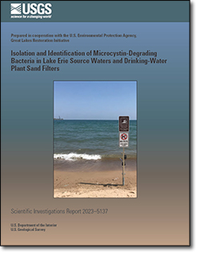Isolation and Identification of Microcystin-Degrading Bacteria in Lake Erie Source Waters and Drinking-Water Plant Sand Filters
Links
- Document: Report (1.91 MB pdf) , HTML , XML
- Data Release: USGS data release - Microcosm experiment data of microcystin-degrading bacteria in Lake Erie source waters and drinking-water plants, 2015–18
- Download citation as: RIS | Dublin Core
Abstract
The increasing prevalence of cyanobacterial harmful algal blooms and the toxins they produce is a global water-quality issue. In the Western Basin of Lake Erie, high microcystin concentrations have led to water-quality advisories, process adjustments for treating drinking water, and increased water-quality monitoring. Biodegradation is an environmentally friendly and cost-effective way to reduce concentrations of microcystins in drinking water; however, few studies have been done to determine biodegradation potential of bacteria indigenous to the Lake Erie watershed. As part of a cooperative program between the U.S. Geological Survey and the U.S. Environmental Protection Agency, this study aimed to identify naturally occurring microcystin-degrading bacteria in source waters and in the sand filters of drinking-water treatment plants in the Western Basin of Lake Erie. Biodegradation of microcystin-LR was found to occur in microcosms developed with three different Lake Erie-area sources—Lake Erie water, water from storage reservoirs supplied by inland streams, and water or solid medium from sand/anthracite filters at drinking-water plants. In microplates with microcystin-LR as the sole carbon source, 10 isolates exhibited cellular respiration and were, therefore, identified as promising microcystin biodegraders; 4 of those isolates subsequently were found to have potential to form biofilms. The 10 promising isolates along with 14 additional isolates from the microcosms were identified by 16S ribosomal RNA sequencing: 15 isolates were γ-proteobacteria, 6 isolates were β-proteobacteria, 1 isolate was an α-proteobacterium, 1 isolate was a flavobacterium in the phylum Bacteroidetes, and 1 isolate was in the phylum Actinobacteria. Isolates were screened for possession of the mlrA gene (found to encode for the protein responsible for cleaving the cyclic structure of microcystin), and results indicate that, for Lake Erie source waters and elsewhere, more work would be required to identify microcystin-biodegradation pathways and products and to confirm biodegradation rates in pure culture isolates.
Suggested Citation
Francy, D.S., Cicale, J.R., Stelzer, E.A., Reano, D.C., and Ecker, C.D., 2024, Isolation and identification of microcystin-degrading bacteria in Lake Erie source waters and drinking-water plant sand filters: U.S. Geological Survey Scientific Investigations Report 2023–5137, 23 p., https://doi.org/10.3133/sir20235137
ISSN: 2328-0328 (online)
Study Area
Table of Contents
- Acknowledgments
- Abstract
- Introduction
- Purpose and Scope
- Materials and Methods
- Results
- Discussion
- Summary
- References Cited
- Appendix 1. Supplementary Tables
| Publication type | Report |
|---|---|
| Publication Subtype | USGS Numbered Series |
| Title | Isolation and identification of microcystin-degrading bacteria in Lake Erie source waters and drinking-water plant sand filters |
| Series title | Scientific Investigations Report |
| Series number | 2023-5137 |
| DOI | 10.3133/sir20235137 |
| Publication Date | January 31, 2024 |
| Year Published | 2024 |
| Language | English |
| Publisher | U.S. Geological Survey |
| Publisher location | Reston, VA |
| Contributing office(s) | Ohio-Kentucky-Indiana Water Science Center |
| Description | Report: vii, 23 p.; Data Release |
| Country | United States |
| Other Geospatial | Lake Erie |
| Online Only (Y/N) | Y |
| Additional Online Files (Y/N) | Y |


